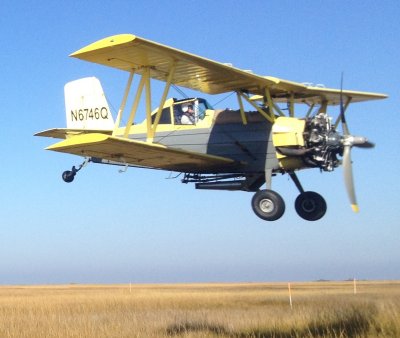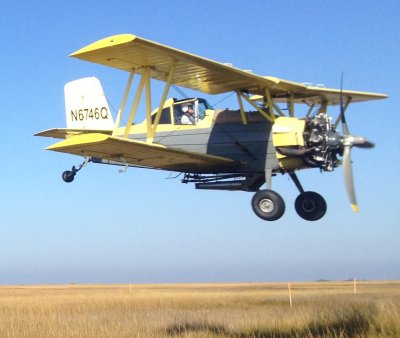news release > tierra resources announces success of air seeding technique to restore wetlands
tierra resources announces success of air seeding technique to restore wetlands
08/25/2015

mangrove planting project delivers globally relevant science for large-scale wetland restoration
nationally certified methodology provides for long-term funding to prevent wetland loss
new orleans, la -- aug. 26, 2015 -- today, tierra resources announced the success of a three-year pilot project to plant mangroves to protect against wetland erosion and hurricane surge. this marks the first successful test of air seeding of mangroves by crop duster airplane, providing a cost-efficient, scalable method to prevent wetland loss.

additionally, the american carbon registry has certified tierra resources' expansion of a wetland carbon quantification methodology that provides a path to market for verified emissions reductions -- issued as carbon credits -- to help finance wetland restoration techniques that prevent wetland loss and the associated release of greenhouse gas emissions. as the tenth anniversary of hurricane katrina approaches, tierra resources, led by dr. sarah mack and in collaboration with 沙特vs墨西哥让球, conocophillips and other companies, has developed the science and research to help fund and implement projects to restore america's wetlands, which provide critical protection to the nation's seafood, maritime trade, and oil and gas industries.
"louisiana's wetlands protect a large portion of our nation's seafood industry, oil and gas infrastructure and key ports, but they are disappearing in front of our eyes," said dr. mack. "our carbon finance methodology paired with techniques like mangrove air seeding provide the opportunity to expedite wetland restoration at a scale and a cost that hasn't been done before. this innovation is vital to the protection of our region's communities, culture, and the national economy."
it is estimated that louisiana experiences wetland loss equivalent to one football field every hour. [1] as these wetlands and waterways disappear, so does the protection of a region critical to the nation's economy. for example, a three-week closure of port fourchon from a hurricane would result in national losses of $11.2 billion in sales, $3.1 billion in household earnings and negatively impact nearly 65,000 jobs.[2] oil pipelines at risk in the surrounding wetlands provide a critical connection to the nation's refineries. the loss of coastal wetlands is not a local problem. it is an american crisis that requires the support of public and private entities.
tierra resources selected mangroves for the project due to their ability to thrive in saltwater environments while protecting fish habitat and establishing complex root systems to reduce erosion. mangroves protect communities and industry by slowing hurricane surge and reducing related flooding. tierra resources utilized the innovative method of air seeding by crop duster airplane, which proved successful at approximately 3 percent of the cost of conventional restoration techniques. mangroves that were seeded in late 2013 are now a few feet high. this new technique establishes a scalable approach to conserve large areas of wetlands, in a short period of time, at a fraction of the cost. while the research focused on terrebonne and lafourche parishes -- including the nationally important port fourchon -- the technique shows potential to expand to other areas of coastal louisiana and around the world.
"we have proven that wetland restoration can be cost-efficient and scalable," stated dr. mack. "the future of this region and its ability to protect itself and the national economy will require new public-private paradigms and a national commitment to environmental stewardship."
after the mangrove planting project's success with conocophillips, entergy announced that they will join forces with tierra resources in 2016 to further demonstrate the scalability and affordability of mangrove air seeding.
"at entergy we understand the economic value of our natural resources and are committed to helping preserve those resources for the benefit of all our stakeholders," said chuck barlow, vice president of environmental strategy and policy. "through our work with tierra resources and other partners, we are helping restore wetlands through a variety of initiatives funded by our shareholders and supported by our employees. mangrove restoration is just one of many initiatives helping to ensure regional and national prosperity and preserve a way of life our customers value."
as tierra resources and its many counterparts and partners in louisiana lead the world in innovating cost-efficient, scalable restoration techniques to prevent wetland loss, creative funding strategies are critical to the viability of these techniques and the future of america's coast.
in early 2015, tierra resources and entergy announced the results of a study that evaluated carbon finance opportunities from blue carbon -- the carbon naturally stored in mangroves and coastal wetlands. the study provided potential positive financial impacts of the american carbon registry's 2012 certification of the methodology, "restoration of degraded deltaic wetlands of the mississippi delta". this methodology, developed by tierra resources and supported by entergy's environmental initiatives fund, introduced wetland restoration to carbon markets. the study showed that carbon finance has the potential to create as much as $1.6 billion in private wetland restoration funding over the next 50 years should the prevention of wetland loss also be included in carbon markets. using the results of the mangrove planting project, entergy's environmental initiatives fund was able to support tierra resources' expansion of the american carbon registry's wetland methodology. this revision accounts for wetland restoration activities that prevent previously stored carbon from being released back to the atmosphere as wetlands erode and convert to open water. the inclusion allows for wetland restoration projects to account for more carbon benefits and may lead to additional long-term funding.
"while funding for wetland restoration remains a critical challenge, the carbon finance methodology provides a strong business case for companies around the country to invest in preventing wetland loss," stated dr. mack.
the gulf coast is building globally relevant restoration techniques and funding strategies to increase economic and environmental sustainability. the commitment of capital and collaboration among companies and public entities will determine the future of the coast and the communities that call it home.
in the next ten years, tierra resources aims to stand by its commitment to preserve wetlands for the next generation by scaling its proven air seeding restoration technique to over 30,000 acres of coastal louisiana.
for questions and more information, please contact abhi bhansali at abhi@tierraresourcesllc.com or 504-400-2882.
# # #
[1] couvillion, b.r., barras, j.a., steyer, g.d., sleavin, william, fischer, michelle, beck, holly, trahan, nadine, griffin, brad, and heckman, david, 2011, land area change in coastal louisiana from 1932 to 2010: u.s. geological survey scientific investigations map 3164, scale 1:265,000, 12 p. pamphlet.
[2] greater lafourche port commission the economic impact of port fourchon: an update. galliano, louisiana. october 2014
